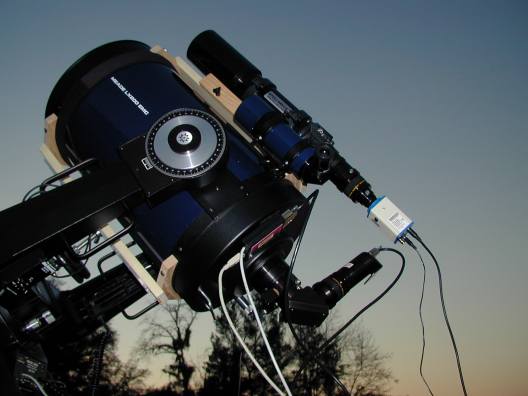
![]()
Updated: 3.16.03
return to equipment
Full Imaging Setup with Video Guider
Here is the scope ready for action. The piggybacked 80mm Stellarvue is equipped with a Mintron 12V1 low lux (0.0001 lux) video camera. The video camera has sufficient sensitivity to capture >mag 12 stars for guiding! It incorporates a special mode that sums 128 frames in a buffer to achieve the added sensitivity. For all of my attempts at guiding using this camera, only once was there not a suitable guide star in the field of view!
The 12"LX200 has the MX7C camera and f/3.3 focal reducer placed into the AP Maxbright diagonal. A usb interface box can be seen attached to the back plate of the 12" towards the left side (held by velcro).
The following items are required to integrate any video camera to a full guider setup:
1 - Video camera - low lux such as the Stellacams (from AVA) or Mintrons. The EX version has 2x the sensitivity of the unit I currently utilize. Make sure that you also pick up a power supply for the camera (the second cable in the picture above).
2 - C to 1.25 adapter - this allows the camera to fit a standard 1.25" eyepiece opening. AVA has these in stock.
3 - S-video cable - provides a better signal than standard composite coax
4 - Frame grabber - I have a cheap Dazzle 80 USB frame grabber w/S-video capabilities. Other more expensive units may have lower noise, but this seems to work well enough.
I currently run the camera's output into the Dazzle 80 frame grabber, which then plugs into a 4 port powered USB hub. I need the hub, since my laptop only has a single USB port and the MX7C camera I use is also USB. The hub then plugs into the laptop.
To operate, run 2 instances of Astroart (start it twice). I use one instance for main camera control and imaging. The other instance is used to control the video camera and guiding. For this, make sure you download the video plugin from the Astroart website. Just operate the video camera as you would any camera for imaging or guiding.

